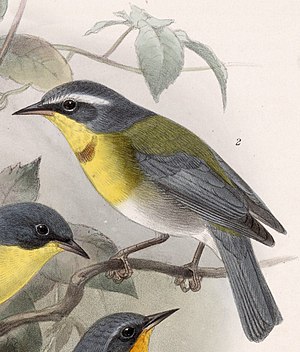Ornamental warbler
| Ornamental warbler | ||||||||||||
|---|---|---|---|---|---|---|---|---|---|---|---|---|

African Warbler ( Oreothlypis superciliosa ) |
||||||||||||
| Systematics | ||||||||||||
|
||||||||||||
| Scientific name | ||||||||||||
| Oreothlypis superciliosa | ||||||||||||
| ( Hartlaub , 1844) |
The jewelry Waldsänger ( Oreothlypis superciliosa , Syn. : Parula superciliosa ) is a small songbirds in the genus Oreothlypis in the family of Waldsänger (Parulidae). The distribution area extends from Mexico via Guatemala , El Salvador , Honduras to Nicaragua . The IUCN lists the species as "not endangered" (least concern).
features
Ornamental warblers reach a body length of 11 centimeters. The wing length is 5.9 to 6.8 centimeters in the male and 5.3 to 6.2 centimeters in the female. Adult wood warbler of the nominate form and young birds from the first year on have a slate-gray crown. The neck, the sides of the neck and the coat are also slate gray. The superciliar stripe is narrow in the front area and hardly protrudes; behind the eye it is broader and white and extends to the nape of the neck. The reins and ear-covers are blackish-gray; the back as well as the shoulder feathers and the trunk olive green and the wings and the tail blackish with gray feather edges and slate gray upper tail-coverts. The throat and chest are olive yellow on the sides, and yellow to light yellow in the middle as well as the upper abdomen. The rest of the underside plumage is white. The beak is blackish; the legs are dark flesh-colored.
Male warblers have a concise, differently colored, crescent-shaped mark over the chest. In the slightly less contrasting colored females, it is narrower. The five subspecies differ only slightly.
Occurrence, nutrition and reproduction
Ornamental warblers are mostly resident birds . Hikes to southern North America are documented . Preferred habitats are in pine-oak forests and cloud forests at altitudes between 1100 and 3500. They feed mainly on insects and other invertebrates . They put the bowl-shaped nest well hidden under dead leaves on the ground. They use moss, grass and pine needles as nesting material. A clutch consists of two to three eggs. The eggs are hatched in thirteen to fourteen days.
Subspecies and distribution
There are five recognized subspecies:
- Oreothlypis s. superciliosa ( Hartlaub , 1844) - Found in the highlands of southeast Chiapas in Mexico, as well as in Guatemala, El Salvador, and western Honduras.
- Oreothlypis s. mexicana Bonaparte , 1850 - Occurs in the Sierra Madre Oriental mountain range in eastern Mexico; from Nuevo León to central Veracruz . Further distribution areas are in Michoacán and Jalisco in western Mexico.
- Oreothlypis s. parva ( W. Miller & Griscom , 1925) - Widespread in the highlands of central and eastern Honduras and Nicaragua.
- Oreothlypis s. palliata ( van Rossem , 1939) - The distribution area extends from southern Jalisco via Michoacán to Guerrero in Mexico.
- Oreothlypis s. sodalis ( RT Moore , 1941) - Occurs in the Sierra Madre Occidental mountain range in northwestern Mexico and from southern Chihuahua to the north of Jalisco.
swell
literature
- Jon Curson, David Quinn, David Beadle: New World Warblers. Helm, London 1994, ISBN 0-7136-3932-6 , pp. 28 and 110.
Web links
- Oreothlypis superciliosa in the endangered Red List species the IUCN 2009. Posted by: BirdLife International, 2009. Accessed on December 9 of 2009.
- Videos, photos and sound recordings on Oreothlypis superciliosa in the Internet Bird Collection
- Ornamental Wood Warbler at ITIS